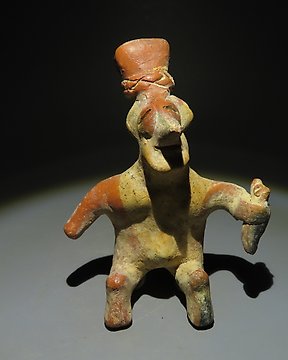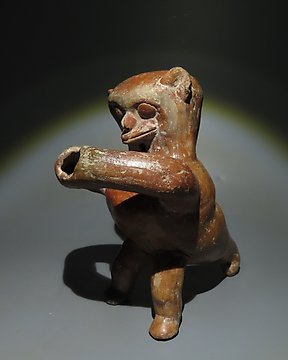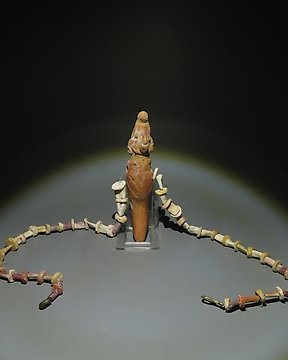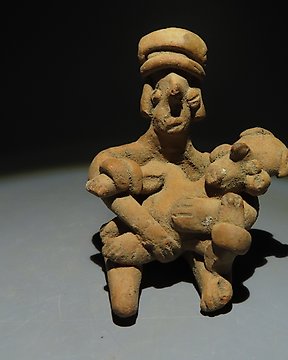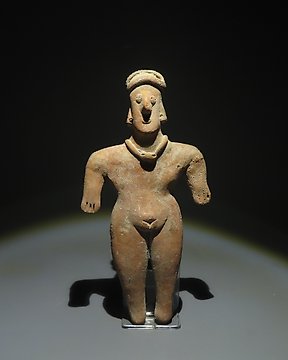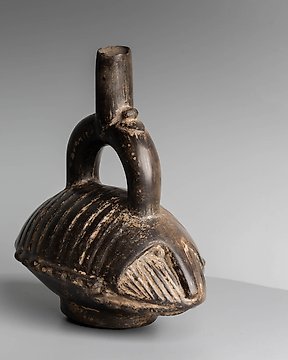All OK and with very fast shipping.
Voir la traductionColima, ouest du Mexique Terre cuite Colima, ouest du Mexique, figure. 200 avant JC - 500 après JC. 20,5 cm H. Licence d'importation
Nº 84860777

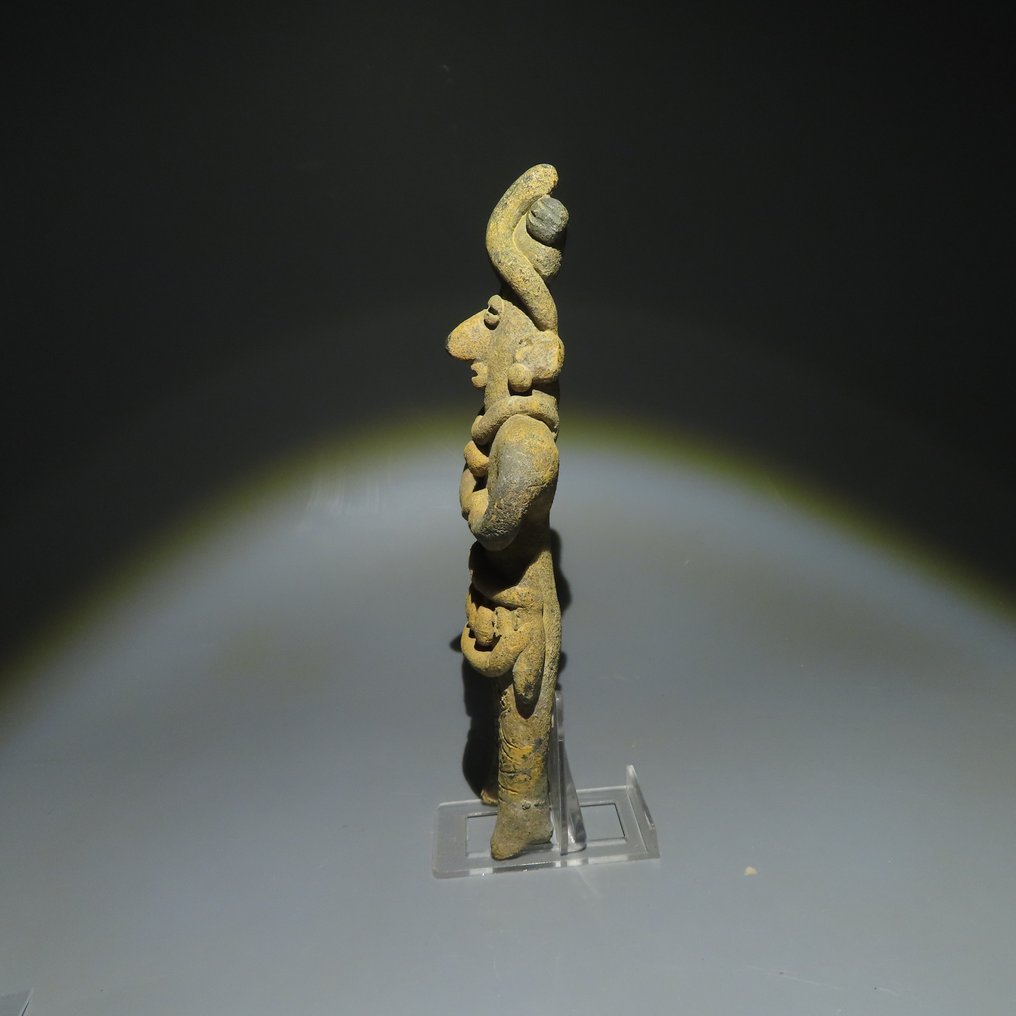
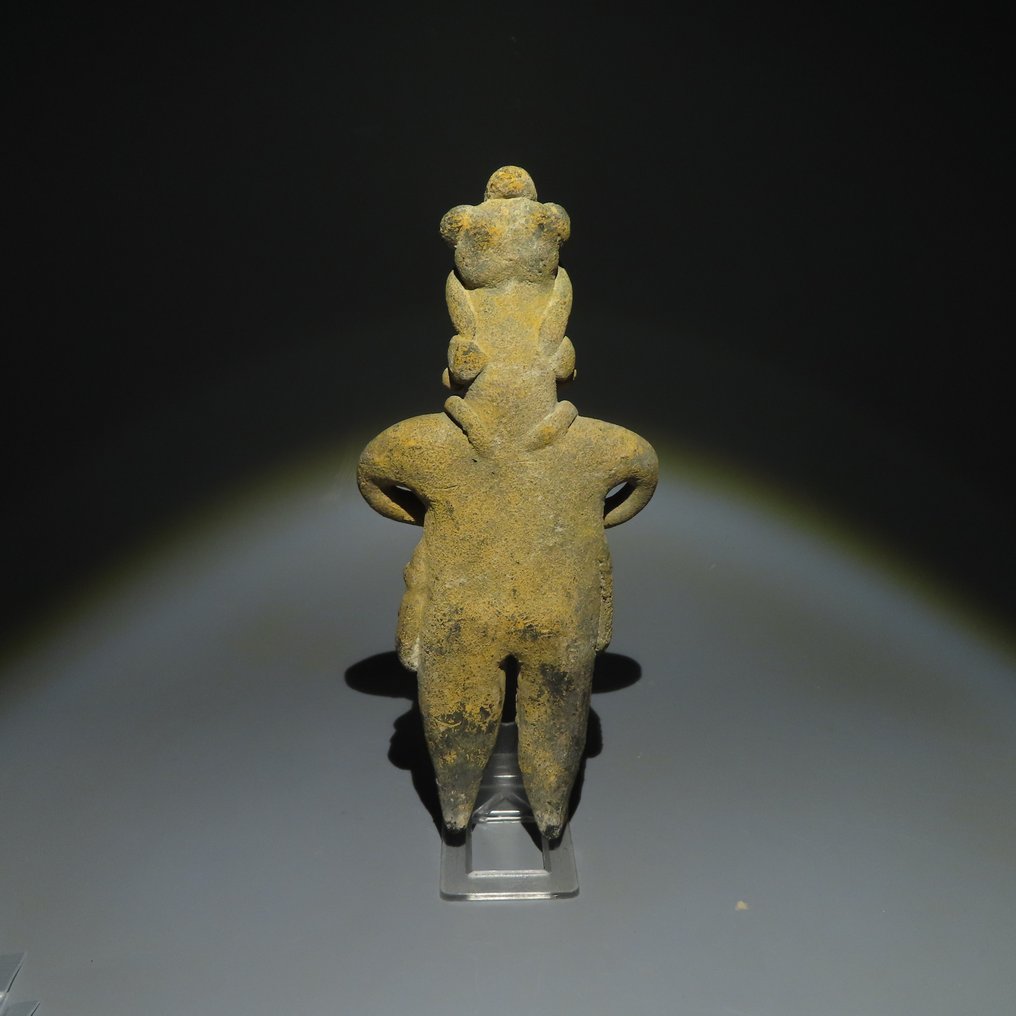
Figure
CULTURE: Colima, Western Mexico
PERIOD: 200 BC - 500 AD
MATERIAL: Terracotta
DIMENSIONS: 20,5 cm H.
PROVENANCE: Private collection, Ex. Dr. David Harner, Arkansas, United States of America, Acquired between 1950 - 1960.
CONDITION: Good condition.
DESCRIPTION:
The Colima people lived in northwest Mexico, in a rugged, low-lying coastal region carved by valleys, each with its own ecology and a warm, humid climate.
Little is known about their modes of subsistence, as most of the information we have comes from artifacts from private collections and from the excavation of cemeteries, not residential sites, which usually provide this kind of information. We do know that they practiced irrigation farming, which allowed them to live in large groups in relatively independent villages and urban centers.
Colima ceramics display a wide variety of figures and shapes, but little variation in technique. Most pieces have a burnished red finish and some are decorated with orange or white incisions. Molded figures are common, especially of plants, animals (especially dogs) and seashells. Human representations typically feature dwarfs and hunchbacks more than others, and few female forms. Many of these figures have “coffee-bean” eyes and are dressed in finely detailed traditional attire. Little is known of Colima stonework; only a few pieces such as mace heads, small masks and figurines have been found. These people also practiced basketweaving and weaving, and used metallurgy to make objects such as needles, axes, rattles, nose rings and ear ornaments.
Little is known about the Colima’s social order, but shamans or priests may have occupied positions of social importance. The existence of figurines resembling warriors as well as prisoners with hands tied points to the ceremonial importance of war in this pre-Columbian society.
The vast majority of ceramic pieces that have been ascribed to this culture are grave goods found in the tombs of individuals of high social rank. The Colima buried their dead in family tombs up to 30 meters deep, some with multiple chambers. The bodies were accompanied by a wide variety of grave goods, including ceramic statuettes of armed men, which served as symbolic guardians. Ceramic sculptures of dogs were another common grave good, and were believed to be the emissaries of Xolotl, the god of death.
The history of the Colima people is not well known, but, like many Mesoamerican cultures, the Colima displayed some stylistic elements that links them with the ancient Olmecs.
Notes:
- The piece includes authenticity certificate.
- The piece includes Spanish Export License.
- The seller guarantees that he acquired this piece according to all national and international laws related to the ownership of cultural property. Provenance statement seen by Catawiki.
À propos du vendeur
Figure
CULTURE: Colima, Western Mexico
PERIOD: 200 BC - 500 AD
MATERIAL: Terracotta
DIMENSIONS: 20,5 cm H.
PROVENANCE: Private collection, Ex. Dr. David Harner, Arkansas, United States of America, Acquired between 1950 - 1960.
CONDITION: Good condition.
DESCRIPTION:
The Colima people lived in northwest Mexico, in a rugged, low-lying coastal region carved by valleys, each with its own ecology and a warm, humid climate.
Little is known about their modes of subsistence, as most of the information we have comes from artifacts from private collections and from the excavation of cemeteries, not residential sites, which usually provide this kind of information. We do know that they practiced irrigation farming, which allowed them to live in large groups in relatively independent villages and urban centers.
Colima ceramics display a wide variety of figures and shapes, but little variation in technique. Most pieces have a burnished red finish and some are decorated with orange or white incisions. Molded figures are common, especially of plants, animals (especially dogs) and seashells. Human representations typically feature dwarfs and hunchbacks more than others, and few female forms. Many of these figures have “coffee-bean” eyes and are dressed in finely detailed traditional attire. Little is known of Colima stonework; only a few pieces such as mace heads, small masks and figurines have been found. These people also practiced basketweaving and weaving, and used metallurgy to make objects such as needles, axes, rattles, nose rings and ear ornaments.
Little is known about the Colima’s social order, but shamans or priests may have occupied positions of social importance. The existence of figurines resembling warriors as well as prisoners with hands tied points to the ceremonial importance of war in this pre-Columbian society.
The vast majority of ceramic pieces that have been ascribed to this culture are grave goods found in the tombs of individuals of high social rank. The Colima buried their dead in family tombs up to 30 meters deep, some with multiple chambers. The bodies were accompanied by a wide variety of grave goods, including ceramic statuettes of armed men, which served as symbolic guardians. Ceramic sculptures of dogs were another common grave good, and were believed to be the emissaries of Xolotl, the god of death.
The history of the Colima people is not well known, but, like many Mesoamerican cultures, the Colima displayed some stylistic elements that links them with the ancient Olmecs.
Notes:
- The piece includes authenticity certificate.
- The piece includes Spanish Export License.
- The seller guarantees that he acquired this piece according to all national and international laws related to the ownership of cultural property. Provenance statement seen by Catawiki.
À propos du vendeur
- 745
- 6
- 0
Prachtig schilderij. Zo blij mee. Zeer nette verkoper en zeer snelle levering.
Voir la traductionperfect ! very fast and high quality delivery !
Voir la traductionAll well! Thanks.
Voir la traductionVendeur très professionnel, top +++×
Voir la traductionPhotos trop contrastées pour bien percevoir les défauts, mais ces défauts étaient visibles pour autant. Le "Bon état" est trompeur. Sinon, envoi rapide et correctement emballé. Frais de port exagérés.
Voir la traductionGreat communication, delivery and product. Came with a well made certificate of authenticity and good packaging. Overall very happy with the purchase! Delivery is a bit expensive, but I recommend it
Voir la traductionMagnifique témoin du passé, envoyé avec tous les justificatifs, impeccable. Encore une fois très satisfait, un grand merci
Voir la traductionThank you for the Special offer and the fast shipping of this excellent piece of art!
Voir la traductionvery good description of the object, very good price for this rare item,. Fast sending (has been at my place 2 days after buying!). Definitely would buy again.
Voir la traductionSehr schön
Voir la traductionAs described, perfect logistic
Voir la traductiongreat seller, everything came as should with certificate of authenticity
Voir la traductionExceptionally well packaged, description aligned with positing received
Voir la traductionReally precious, but without sound...
Voir la traductionPainting well packed and rapidly sent!
Voir la traductionsempre grande rapidità e professionalità
Voir la traductionparfait bien reçu, merci
Voir la traductionVery satisfied with the small Greek Lekythos. As always (we have already bought several items from Bagot), the object was wrapped and sent immediately and with the greatest care.
Voir la traductionPerfect, excellent condition, good packaging, the parcel arrived without any problems… all is perfect as usual. Thank you very much and wait for an other nice piece like this one. Gilles.
Voir la traduction+++ Top vendeur professionnel comme d'habitude
Voir la traductionEmbora o custo de transporte esteja acima da média foi, realmente, muito bem executado e em embalagem cuidada. Expeditos e profissionais. Recomendo
Voir la traductionSnel en correct en goed verpakt verzonden
Voir la traductionoggetto bellissimo, fedele alla descrizione, venditore affidabile
Voir la traductionVery nice piece and fast delivery
Voir la traduction- 745
- 6
- 0
All OK and with very fast shipping.
Voir la traductionMentions légales
Le vendeur garantit que l'objet a été obtenu légalement et est en mesure de le prouver. Le vendeur a été informé par Catawiki qu'il devait fournir les documents requis par les dispositions législatives et réglementaires de son pays de résidence. Le vendeur garantit qu’il est autorisé à vendre/exporter cet objet. Le vendeur fournira à l'acheteur toutes les informations connues sur la provenance de l'objet. Le vendeur veillera à ce que tous les permis nécessaires soient (déjà) obtenus. Le vendeur informera immédiatement l'acheteur en cas de retard dans l'obtention de ces permis.
Le vendeur garantit que l'objet a été obtenu légalement et est en mesure de le prouver. Le vendeur a été informé par Catawiki qu'il devait fournir les documents requis par les dispositions législatives et réglementaires de son pays de résidence. Le vendeur garantit qu’il est autorisé à vendre/exporter cet objet. Le vendeur fournira à l'acheteur toutes les informations connues sur la provenance de l'objet. Le vendeur veillera à ce que tous les permis nécessaires soient (déjà) obtenus. Le vendeur informera immédiatement l'acheteur en cas de retard dans l'obtention de ces permis.

